On that day we left Pyongyang. We met our guides after breakfast and they gave us our passports and our “sealed” mobile phones.
In the passport we now also had some kind of registration stamp and another stamp, which allowed us to leave via Sinuiju:

Before going to the station, we had another metro ride. We asked our guides the day before about that, because Oliver, who is also quite interested in public transportation, stayed at the hotel when the scheduled metro-ride took place.
Also the 2nd metro-ride was between the two stations, which are usually shown to tourists:
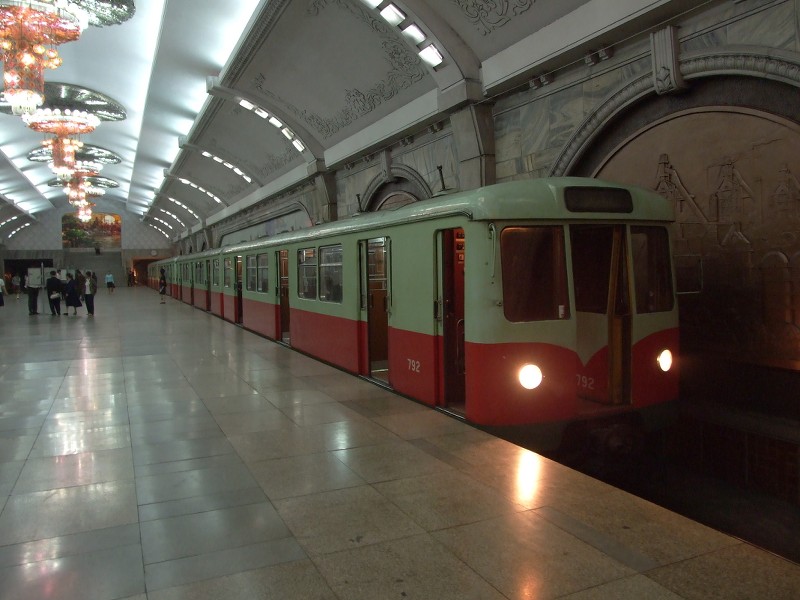

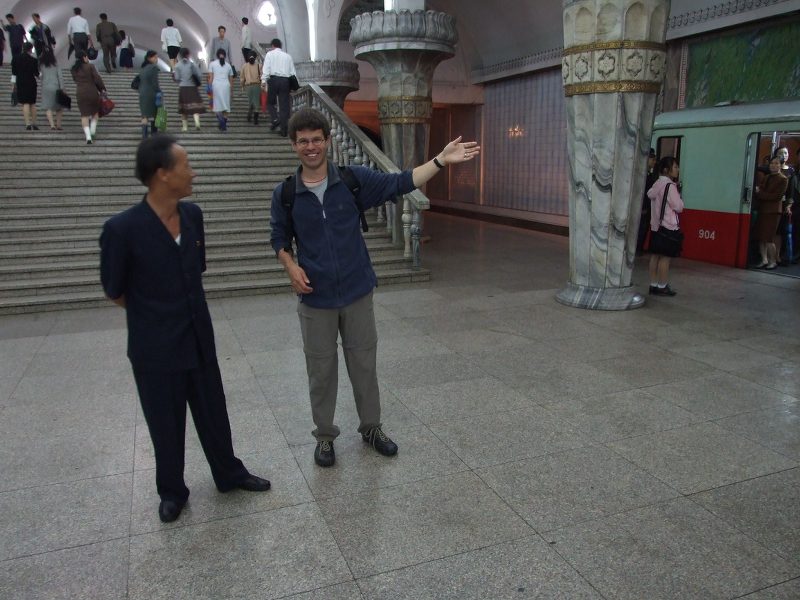
From Yonggwang station we walked to the train station.
Tramway reconstruction also here:

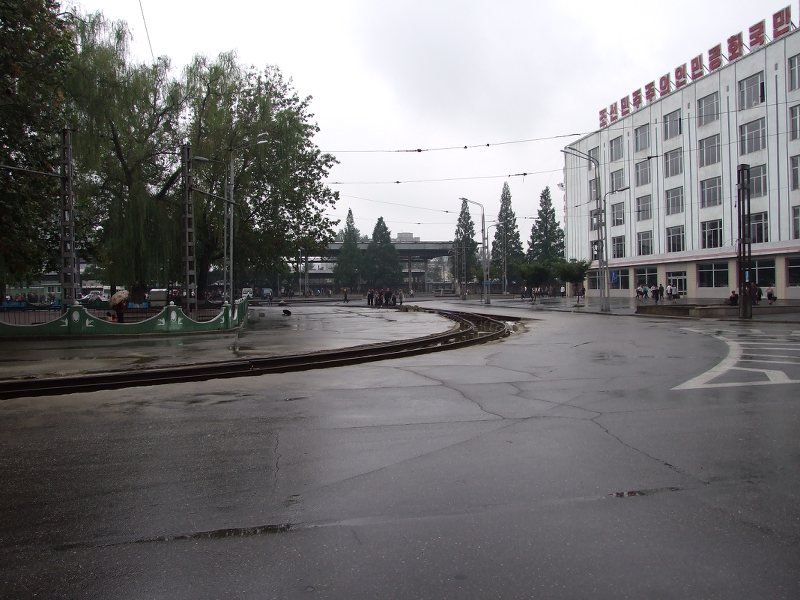
Pyongyang train station:

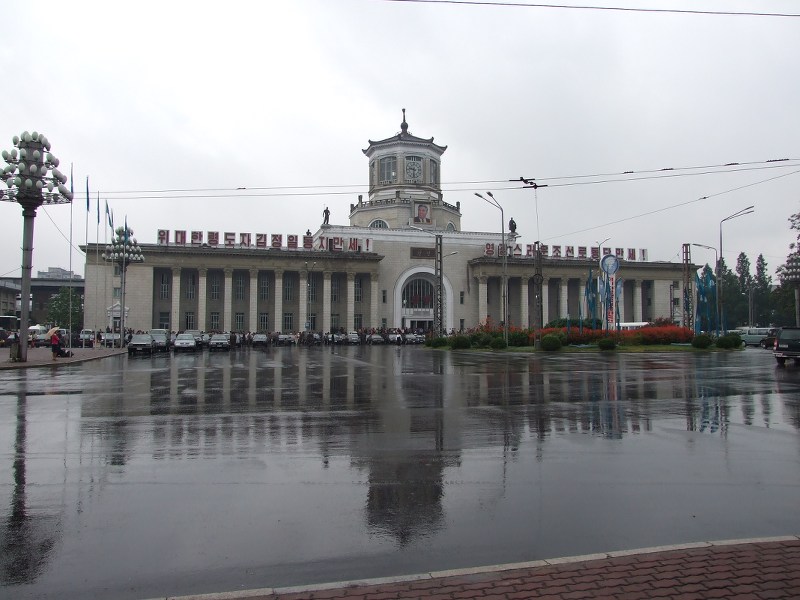
The train tickets to Beijing, which we had picked up the day before at the KITC-office:
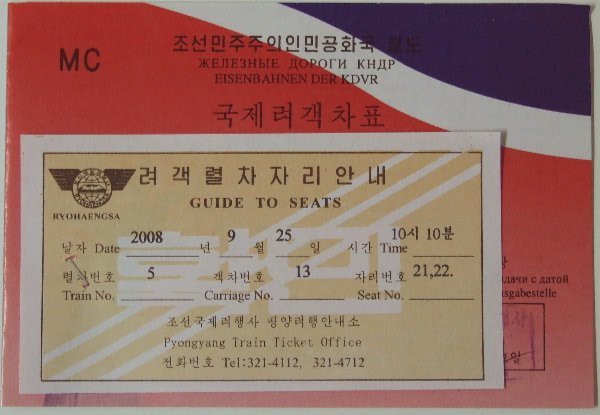
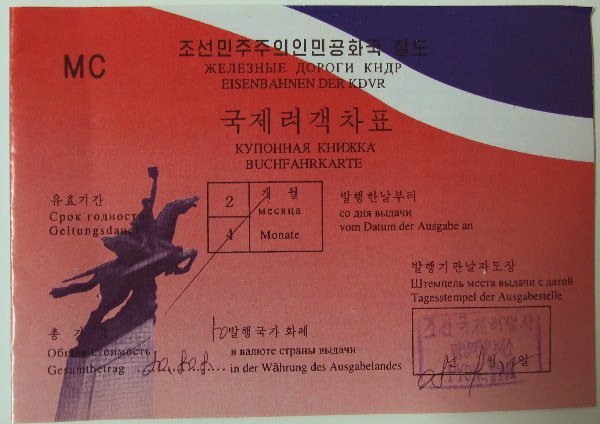
2nd class ticket:
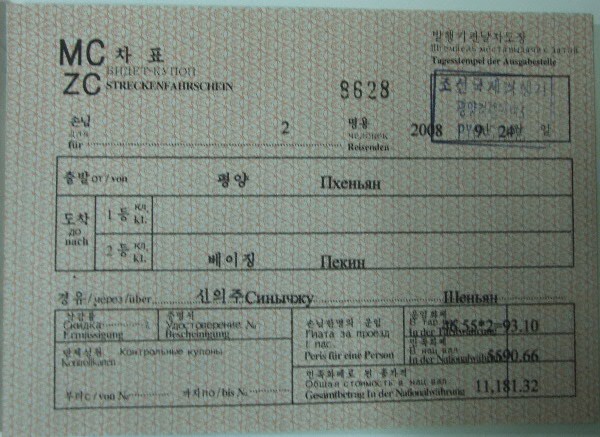
Sleeper reservation:
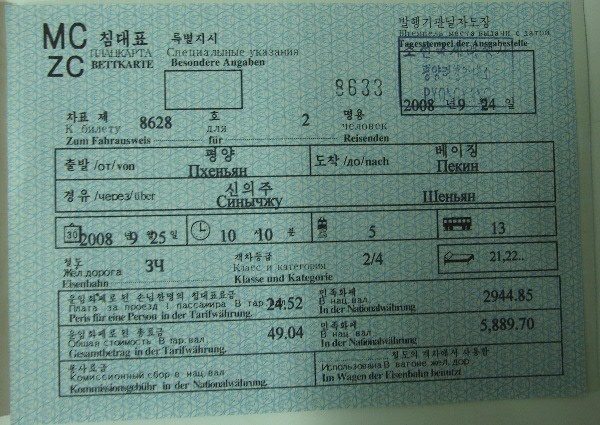
The price of the basic ticket was 46,55 CHF per person, the obligatory sleeper upgrade cost 24,52 CHF.
The official exchange rate is 1 CHF = 120,1 KPW.
Ticket rules:
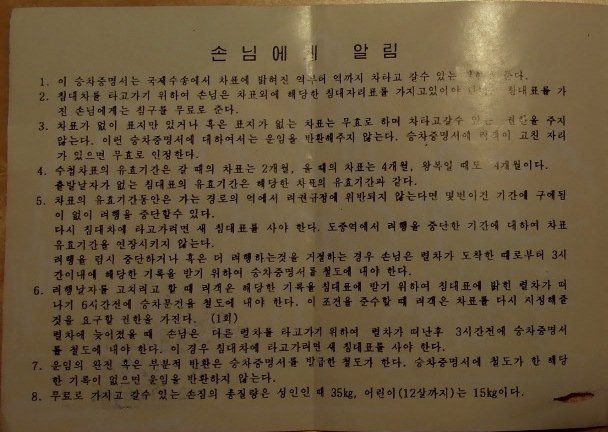


Everything is written in Korean, Russian and German. For thos who wonder about this languages: The legal base, under which international train train-ticketing between the railways of the states of the former USSR, Mongolia, China, North Korea and Vietnam is organized, is the so-called MPT-tariff (“mezhdunarodnyj passashirskij tarif”. Till around 1990 also the railways of the former socialist countries in Europe (among them: Eastern Germany) where members at this tariff agreement. The rule was (and is still today) that inscriptions on tickets have to be in Russian and German and the language of the issuing railway.
Here you can see other MPT-tickets issued in Mongolia and China:
Mongolian ticket Ulaanbaatar – Beijing:

Chinese ticket Urumqi – Almaty:
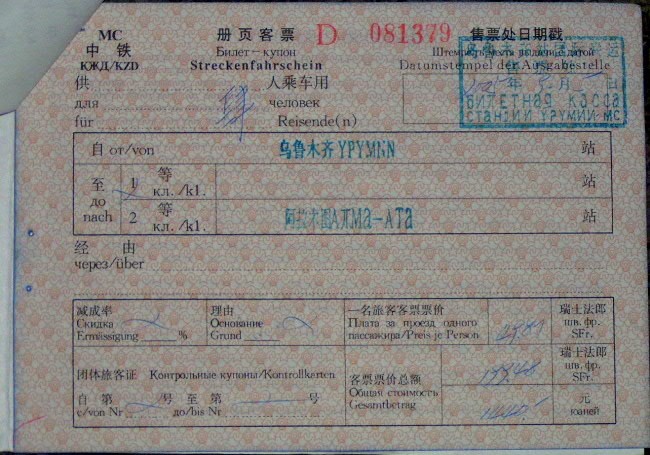
Two other interesting facts:
The prices of the MPT-tariff are fixed in Swiss Francs. That’s why the price on the ticket is usually listed in Swiss Francs and the local currency.
20 years ago prices were much cheaper. An interesting comparison for international ticket prices of the Polish railways in 1988:
Warsaw – Pyongyang: 11.598 Zloty
Warsaw – Vienna: 11.557 Zloty
So nearly the same price (was then about 480 Austrian Schillings (35 EUR)) for 12.000 and 600 kilometers. But the difference was that different tariff agreements applied: The MPS-tariff with heavily subsidized fares between socialist countries and the TCV-tariff for tickets to capitalist countries.
I know some people from Austria who made Transsiberian trips to Beijing in the 1980ies and bought in Hungary cheap tickets to Beijing for nothing – only a few hundred schillings…
We were guided to a special loung for international passengers, where we waited maybe 10 minutes.

At the platform:
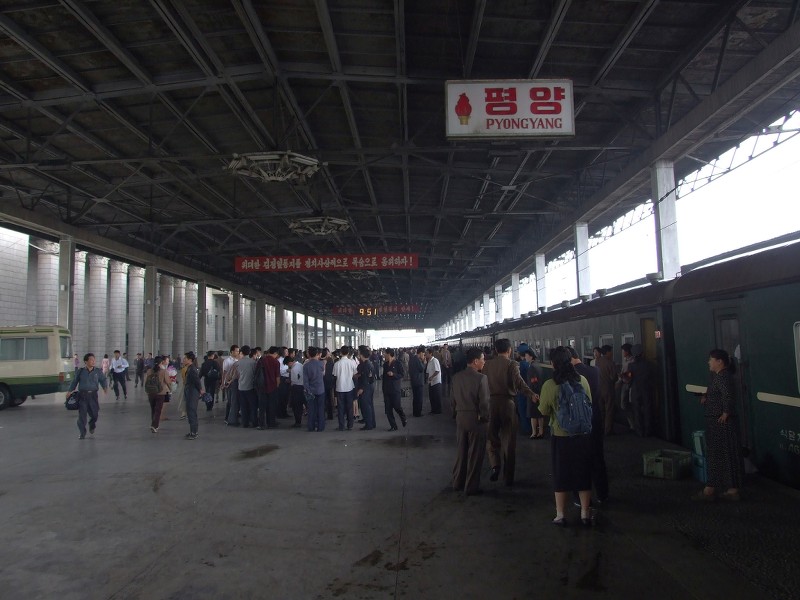
We gave a tip and some souvenirs from Austria and Switzerland to our guides and said good-bye.
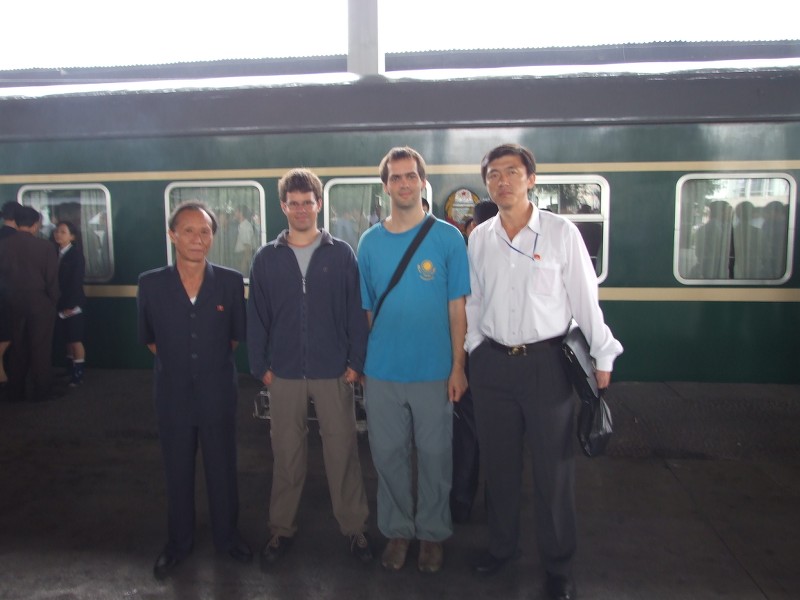
We left Pyongyang with ambivalent feelings at 10:10. On the one hand we had a good and interesting time here with our guides, but on the other hand we were now quite relieved, that finally everything went well and no further problems during our stay in Pyongyang occurred, which was not 100% sure considering how we arrived…
Of course the greatest excitement was between the departure from the Russian border village Khasan and the first (friendly and thus encouraging for the further procedure) contact with the North Korean border soldiers at Tumangan.
But would there be any examination in Pyongyang? Would someone search for photos taken at Tumangan and during the trip?
Now that we departed we were quite sure that the remaining border control at Sinuiju would only be a small hurdle.
BTW, for those who still wonder, how the guides knew about our arrival time in Pyongyang (many readers asked me about this indeed quite interesting detail): Well, we took precautions so that KITC knew about our exact arrival time - early enough to inform the guides, but late enought to not be able to prevent our entry at Tumangan...
The timetable from Pyongyang to Beijing:
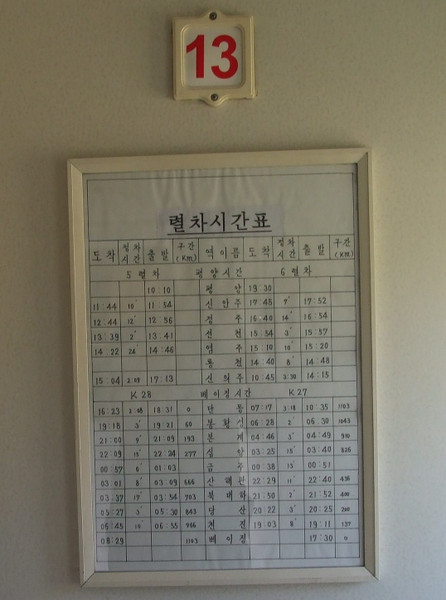
+-----------------------------------+-----------+-----------+----------+
| station | arrival | departure | train |
+-----------------------------------+-----------+-----------+----------+
| Pjöng Yang | | 10:10 | 5 |
| Sinanzhu | 11:44 | 11:54 | |
| Chzhontu | 12:44 | 12:56 | |
| Sonchon | 13:39 | 13:41 | |
| Yomzhu | 14:22 | 14:46 | |
| Sinuiju (North Korean border town)| 15:04 | 17:13 | |
| Dandong (Chinese border town) | 16:23 | 18:31 | K28 |
| Fenghuangcheng | 19:18 | 19:21 | |
| Muxi | 21:00 | 21:06 | |
| Shenyang | 22:09 | 22:24 | |
| Jinzhgou | 00:57 | 01:03 | |
| Shanhaiguan | 03:01 | 03:09 | |
| Beidaihe | 03:37 | 03:54 | |
| Tangshan | 05:27 | 05:30 | |
| Tianjin | 06:45 | 06:55 | |
| Beijing | 08:29 | | |
+-----------------------------------+-----------+-----------+----------+
The train consisted of two sleeping-cars going to Beijing. Then there was a dining car and maybe 10 domestic waggons, which only went to Sinuiju, the North Korean border town.
The sleeping cars to Beijing are the newest waggons of the North Korean railways, they are new Chinese-built waggons.
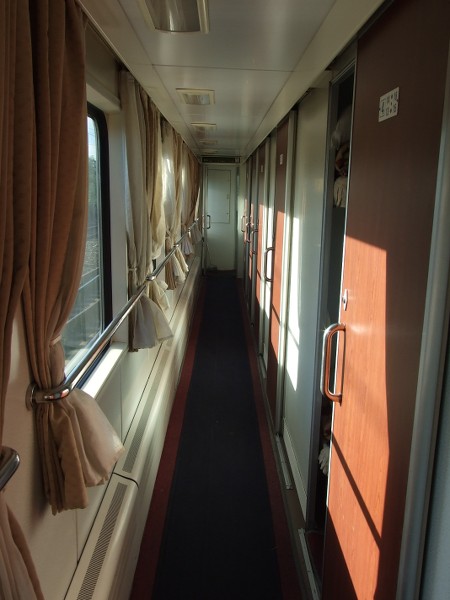
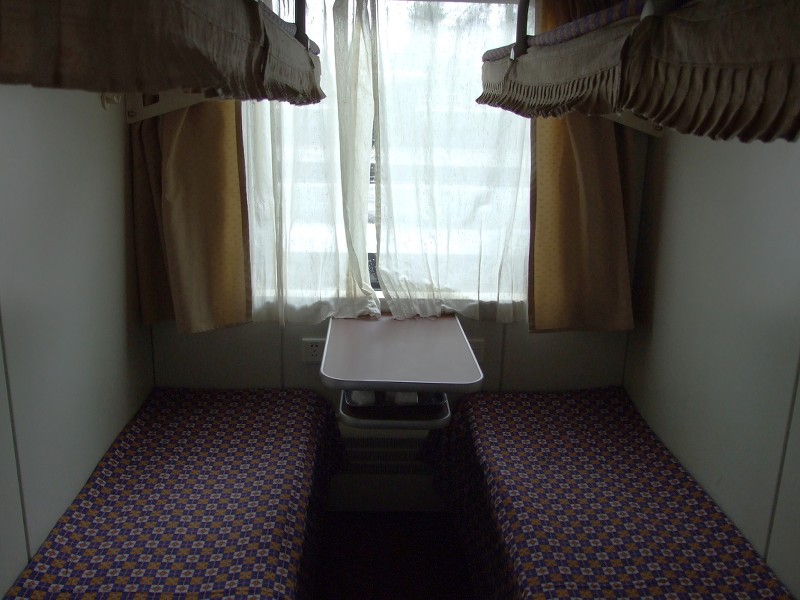
Also interesting: The train was pulled by a diesel-locomotive, alltough the line to Sinuiju is electrified. Maybe this is to guarantee punctual operation in case of electric power blackouts.
So, one can see that this train – unlike the train from Tumangan – has a special status…
Another train close to Pyongyang:
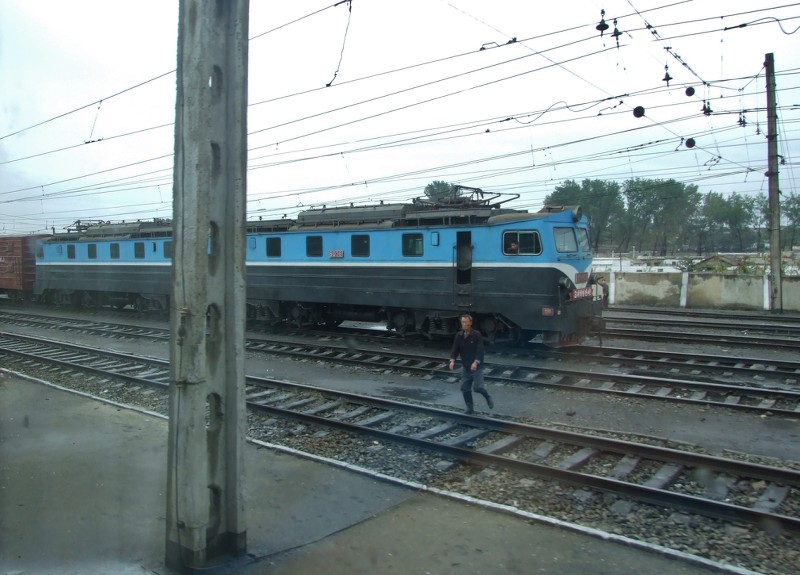
Apart from the length the train line from Pyongyang to Sinuiju is similar than the line from Tumangan. Similar things can be seen from the train window, the villages and towns on the Tumangan-line don’t look worse in my opinion.
However, the track condition is better (but still far away from good) on the Sinuiju-line. Whereas the average speed between Tumangan and Pyongyang was only 29 km/h (860 km in 30 hours), it is 46 km/h between Pyongyang and Sinuiju.
But also the line Pyongyang – Sinuiju had seen better times:
1981: 60 km/h, 3h45 (source: International timetable of the Soviet railways, see http://img505.imageshack.us/img505/21/szd052.jpg or download the whole timetable book at http://www.file-upload.net/download-10725360/SZD-international-timetable-1981.zip.html (10 MB))
1997: 50 km/h, 4h30 (source: http://www.transport.ru/20/timetbl/intern/m_pxenjan2.htm)
2008: 46 km/h, 4h54
We had a lower and a upper bed in a 4-bed-compartment, which we shared with tow North Korean diplomats.
The international sleeping cars were fully booked, but there were no other Western tourists. The other passengers also seemed to be privileged North Koreans or Chinese tourists.
The diplomats spoke some english, and it was interesting for us to see their passports – and for them to see ours.
They had an interesting collection of visas, mainly from African countries. One of them also had a Swiss visa with entry/exit stamps from Geneve. The other one once took the train from Moscow (to where he flew) to Sofia via Ukraine and Romania, he had a Romanian transit visa and the stamps from Brjansk/Konotop, Vicsany/Vadul Siret and Giurgiu/Russe.
Now they went to Beijing from where they continued by plane to Africa (they didn’t mention the country).
A North Korean passport:
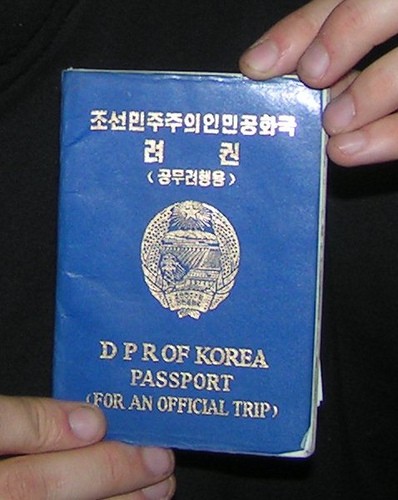
(photo was taken in December 2006, when I travelled from Moscow to Irkutsk in the North Korean sleeping car)
At Sinanju station:
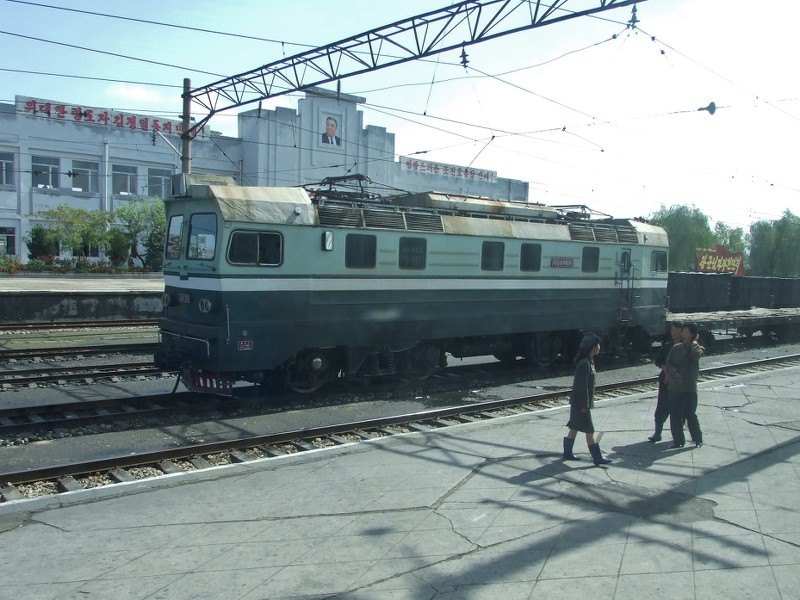
After leaving Sinanju a waitress from the dining car came to our waggon and asked whether we would like to have lunch in the dining car for 5 EUR.
That’s we we then did:
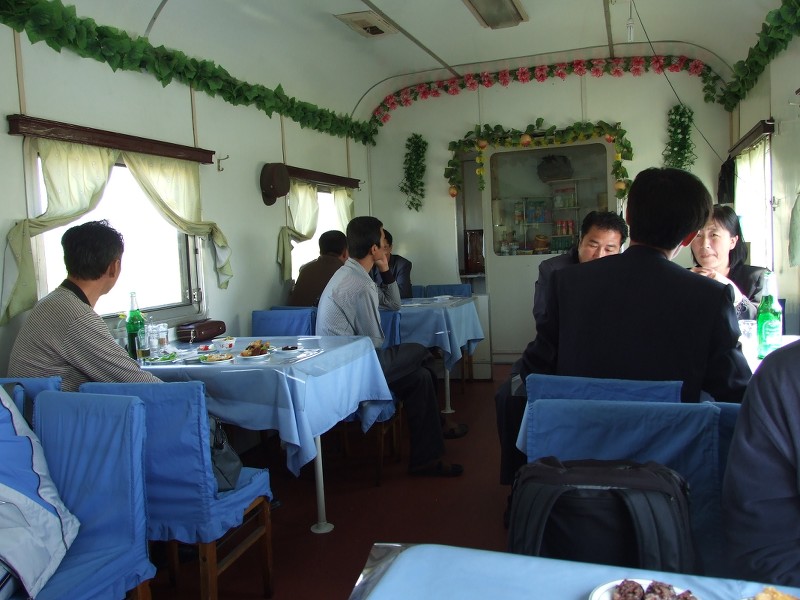
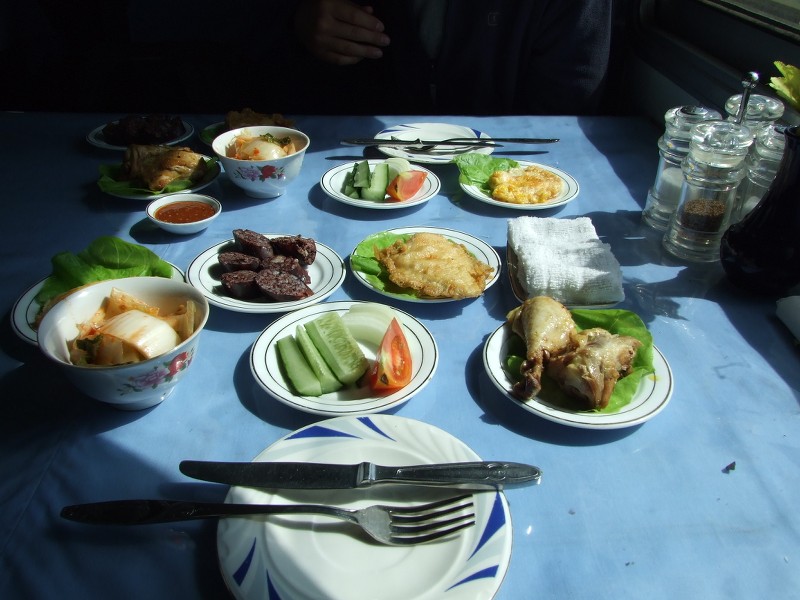

To my surprise Heineken beer was served:
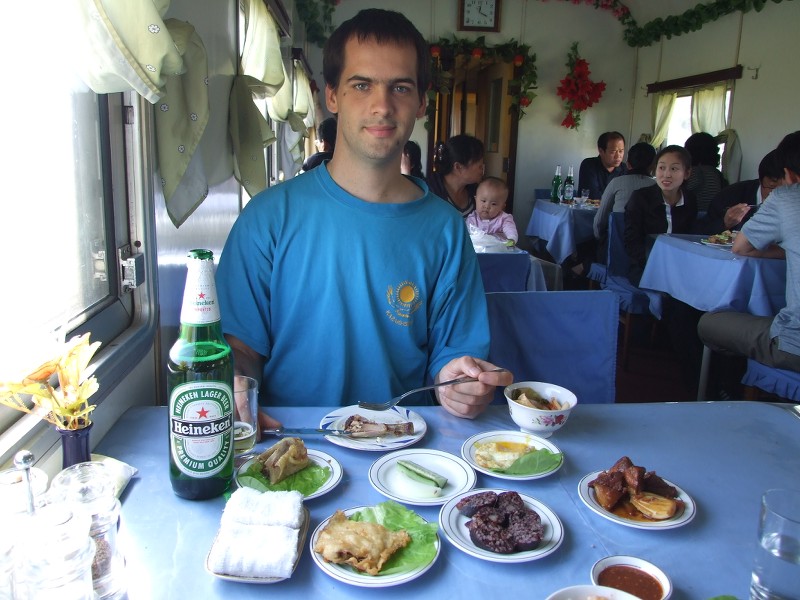
Freight train at Sonchon:

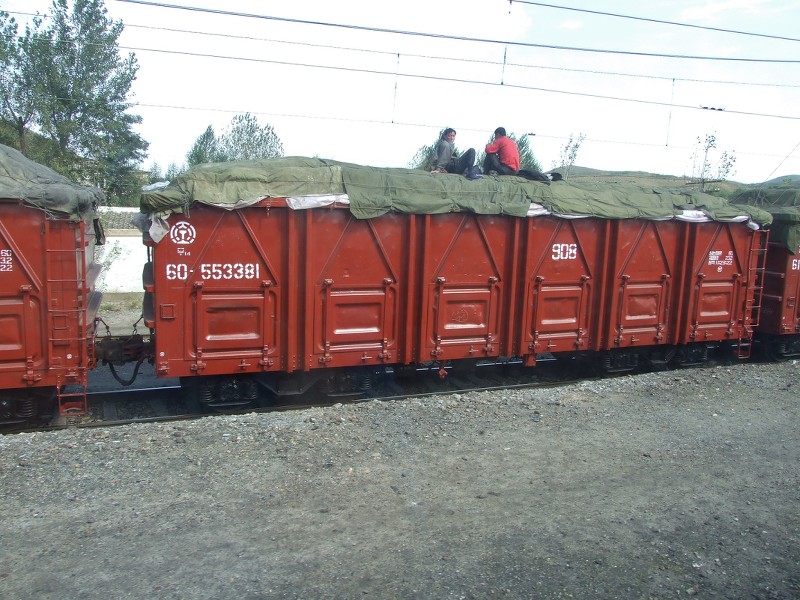
About 30 minutes before arriving at Sinuiju we had to wait on a siding for the Beijing – Pyongyang train, which conveyed three instead of as usual just two international waggons.
Apart from that train we met two or three other passenger trains in the opposite direction between Pyongyang and Sinuiju.
Finally we arrived at Sinuiju. The border stop lasts for two hours. Soldiers came and collected our passports. Other soldiers checked our luggage, but no one asked for the customs declaration, which I filled in at Tumangan. So I still have it ;-)
Of course laptop and digital camera were of special interest for customs officials. One officer checked the photos on the camera – I knew that something like that would happen…but that was the reason that I took a laptop with me.
So only the usual tourist photos were saved on the memory card. And the above photos of the freight train with the people I moved to the internal memory of the camera after I took them. They are not shown in the play-modus, if a memory card is inserted…
However, I was also asked to switch on my laptop, but they didn’t really search for photos.. And even if they had searched for photos, I’m sure they wouldn’t have found them (renamed zip-file, looked like a windows system file and saved somewhere in C:/windows….Ok, I’m sure there are more professional ways to hide files, but that seemed the easiest way for me being no computer-expert).
Apart from the photos I could also smuggle a 5.000-won banknote out of the country. I bought this souvenir from one of our fellow passengers during the train ride Tumangan – Pyongyang. The price was according to the black-market rate: 1,15 EUR for 5000 Won (4350 KPW = 1 EUR, official rate: 185 KPW = 1 EUR)

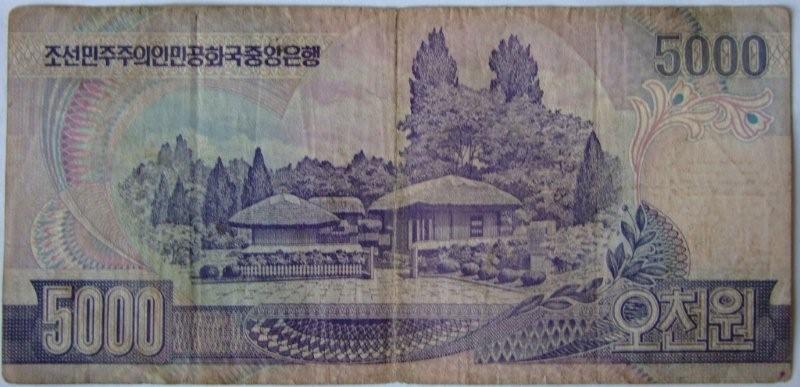
Finally the passports were returned to us:

Entry at Tumangan (두만강), Exit at Siniuju (신의주) – our experiment was a success!!
We were now also allowed to unwrap our mobile phones. I switched it on and as we were close to China I could also send some sms using the Chinese mobile network.
Finally we left Siniiju and crossed the Yalu-river over to Dandong in China:
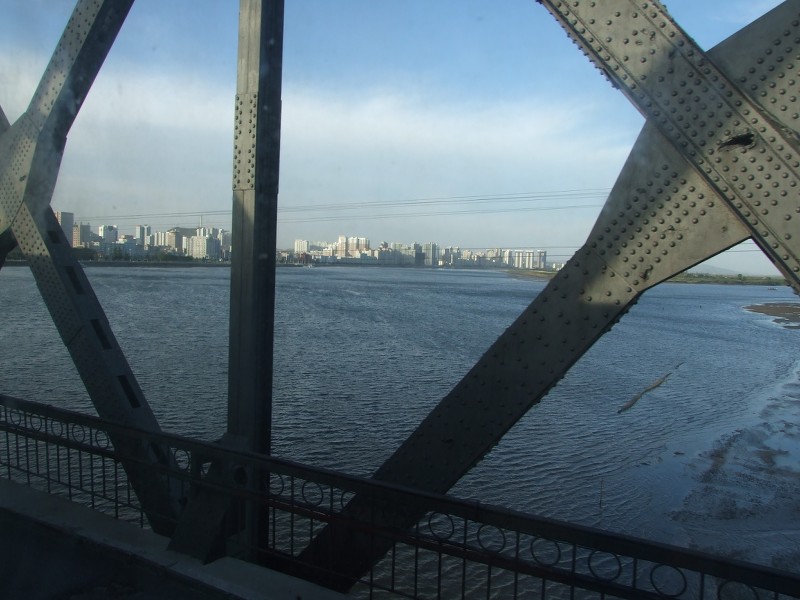
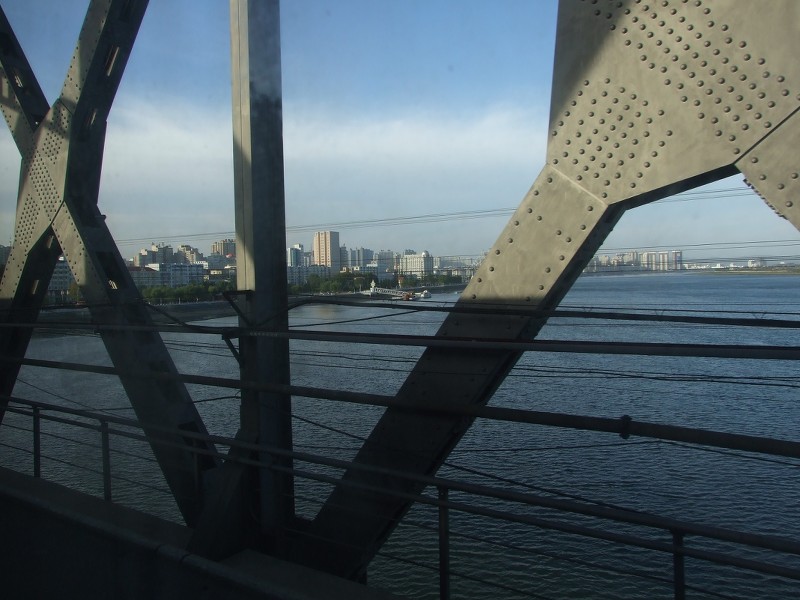
Alltough also China is also exotic for us, we now had the feeling that were going back to “our” world…
The station at Dandong was just being rebuilt:
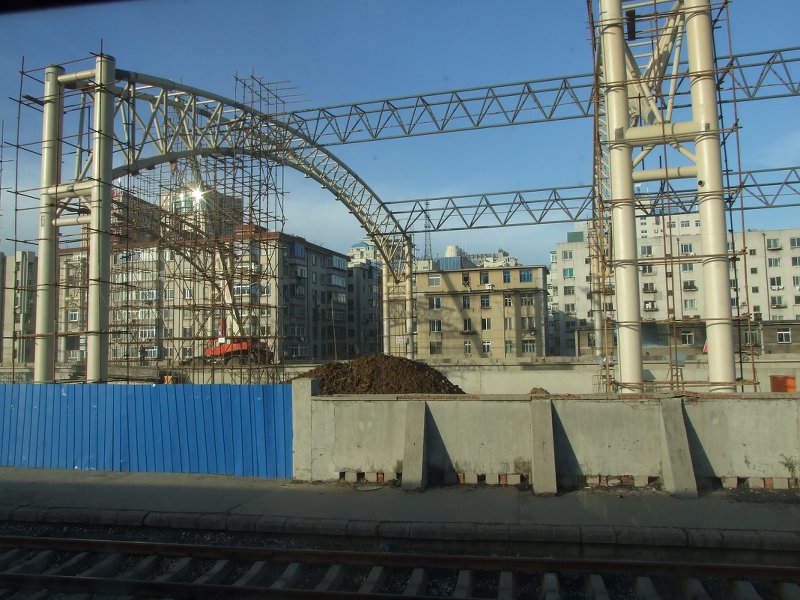
The Chinese border control is not really worth mentioning, no questions, no luggage control, they just checked our temperature…
My Chinese visa:
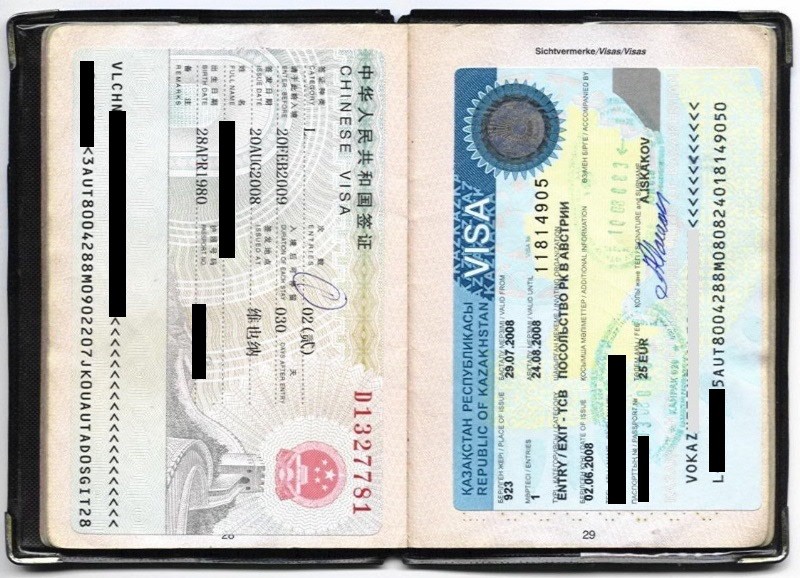
We got double-entry visas, alltough we needed only one entry. But we wanted to be flexible if we had to cancel the Tumangan-experiment at short notice for some reason.
Chinese entry and exit (received some days later) stamp:

The border control was finished at 17:00 – half an hour after we arrived. Meanwhile the two international waggons were coupled to a long Chinese domestic train.
We got off to make some photos.
A local train from Sinuiju to Dandong just arrived. We saw this train already at Sinuiju, it seems as it is intended for local Chinese and Korean traiders.
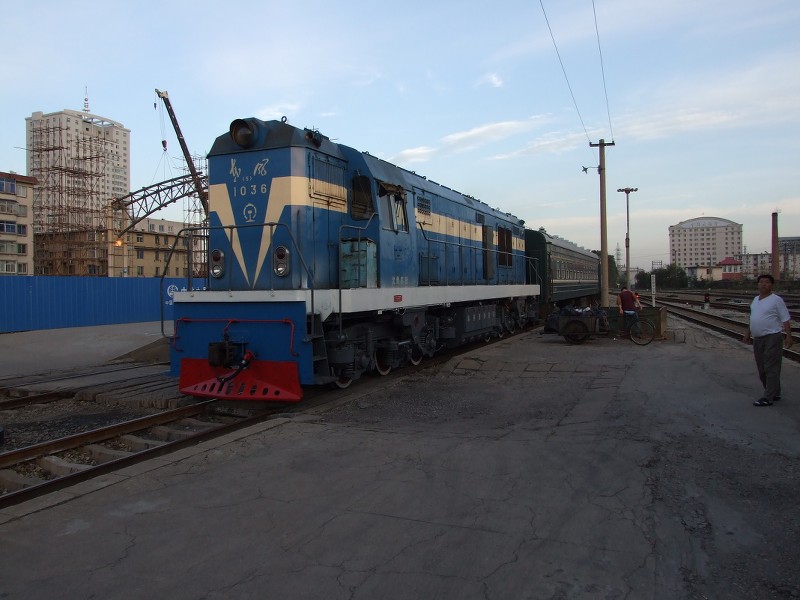
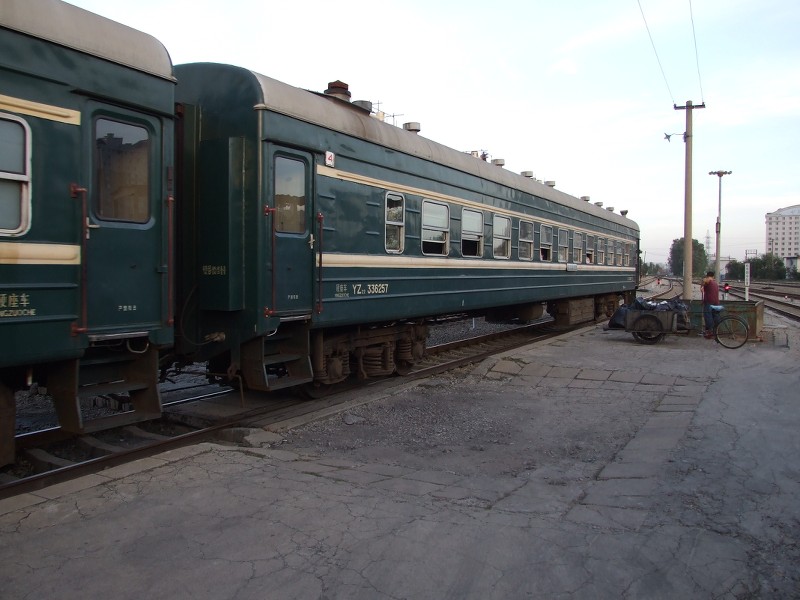
The two Pyongyang – Beijing sleeping cars:
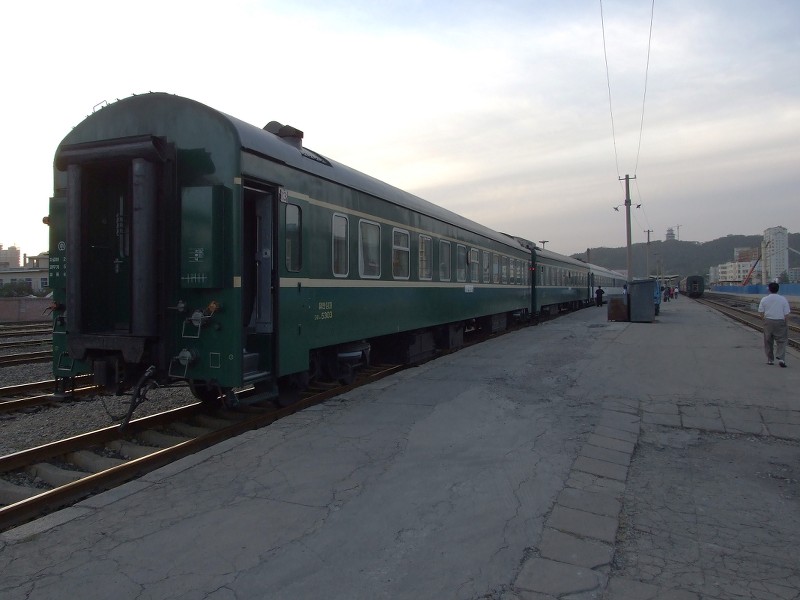
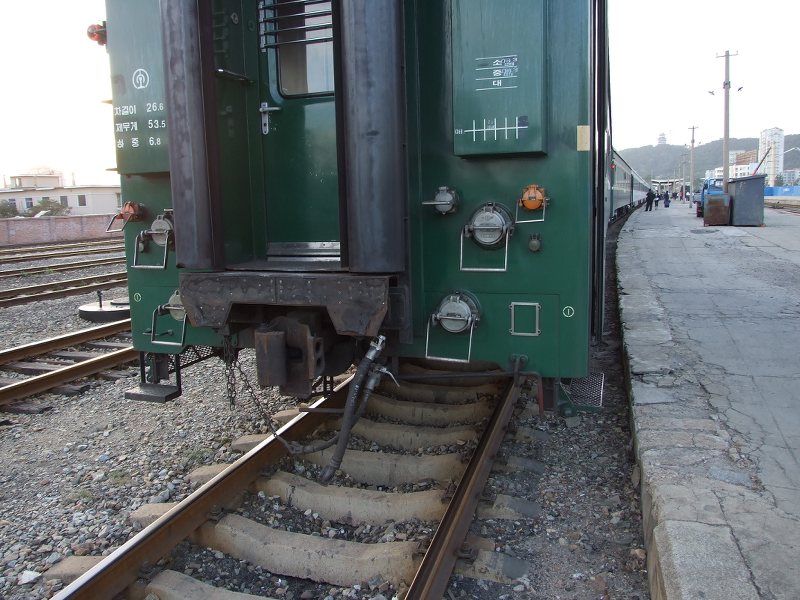
Air-suspended boogies:
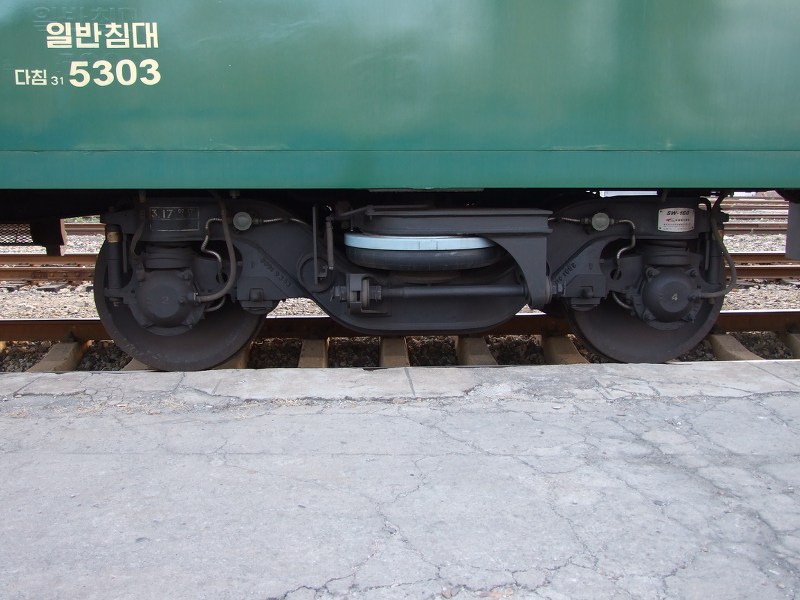
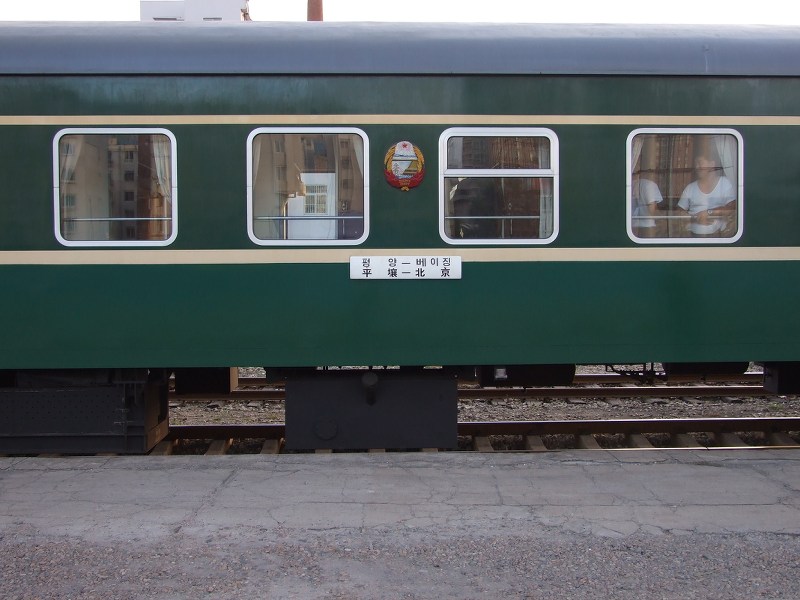
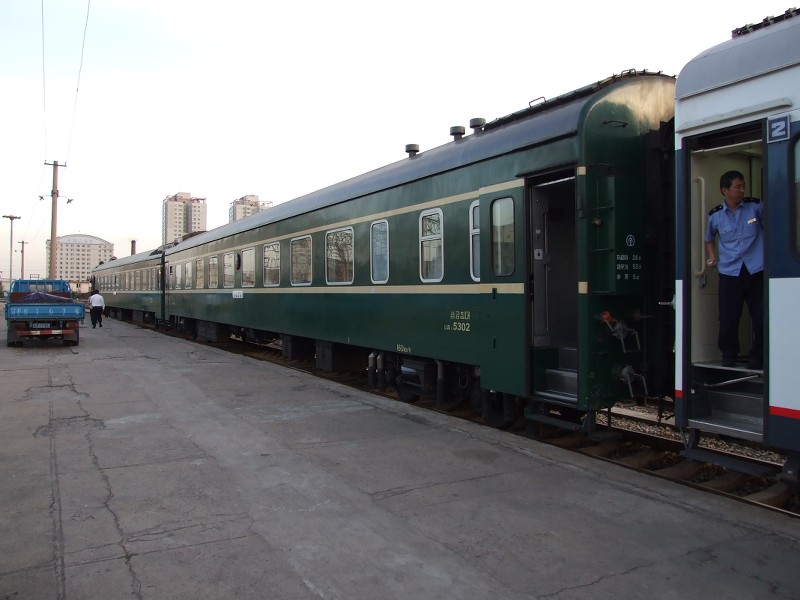
The domestic Chinese portion of the train:
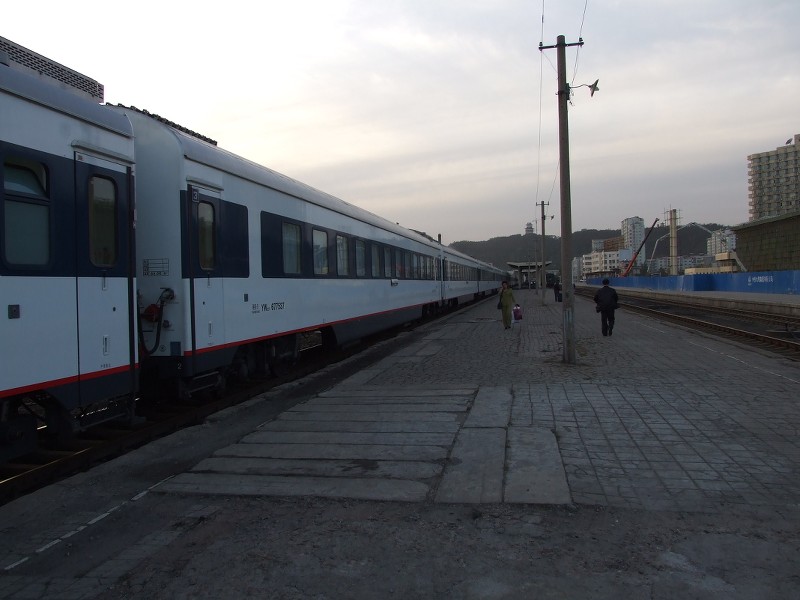
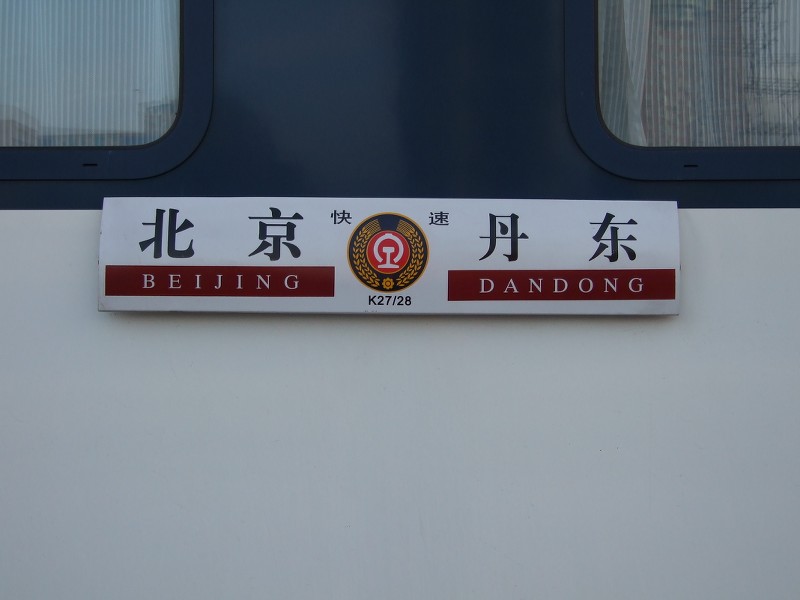
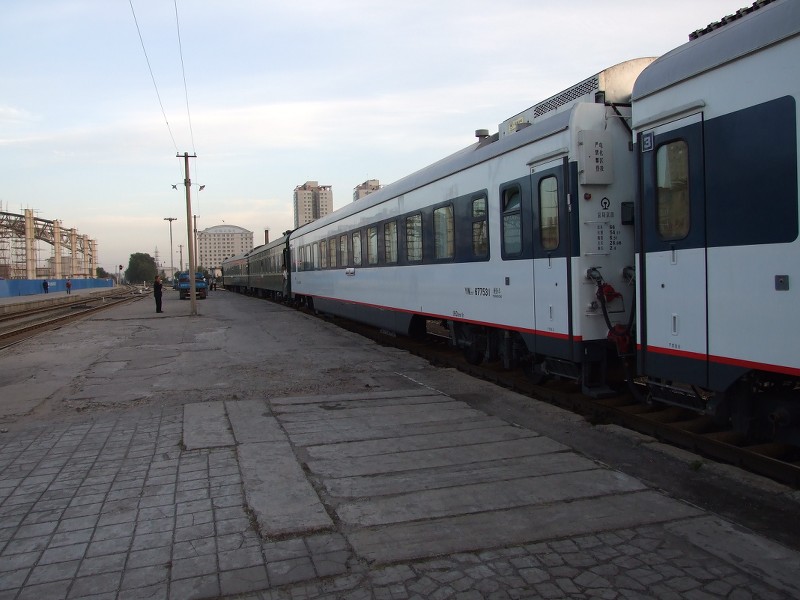
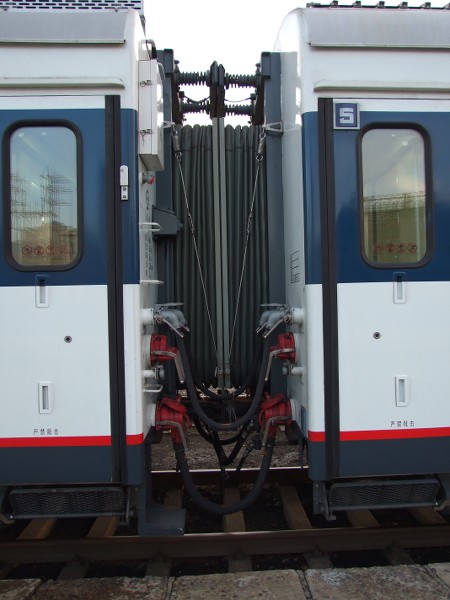
On the right – the local train from Sinuiju:
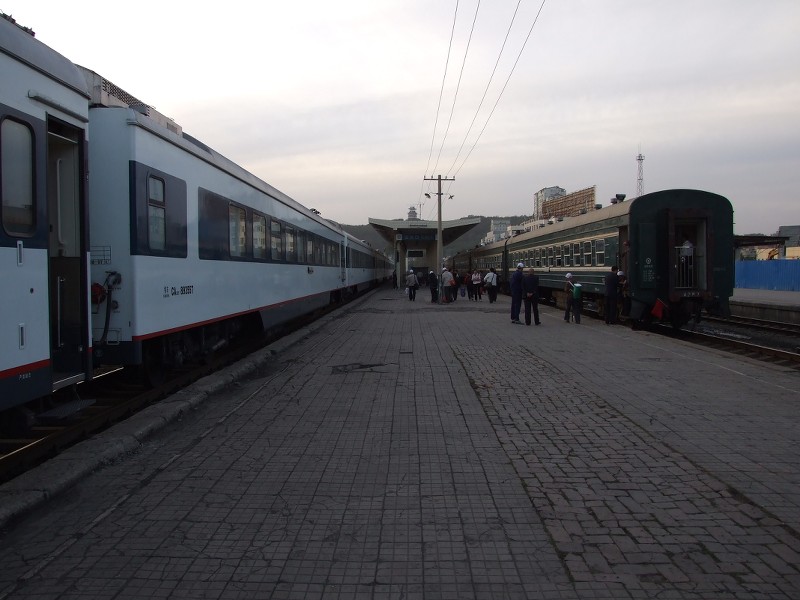
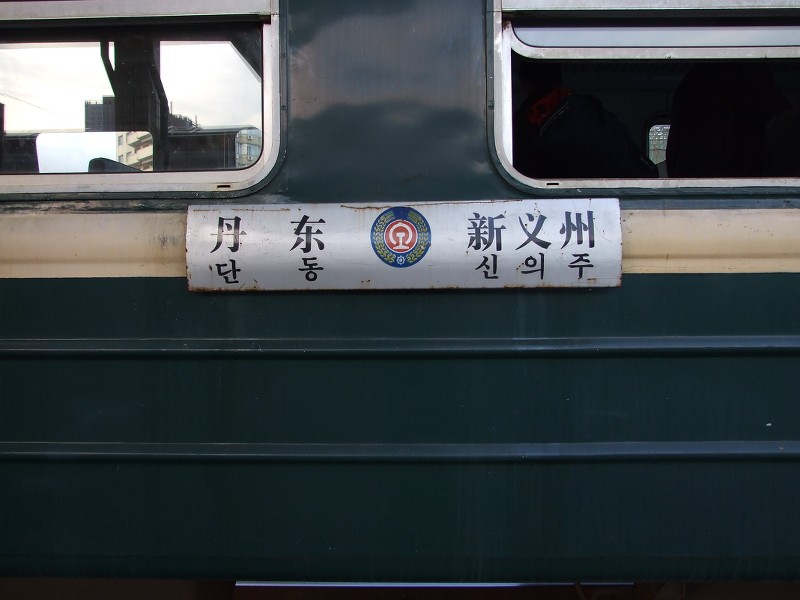
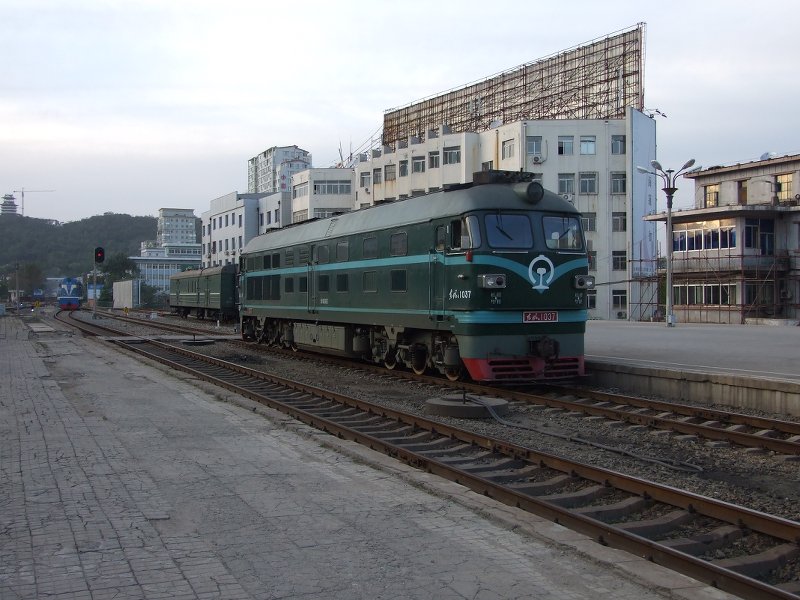
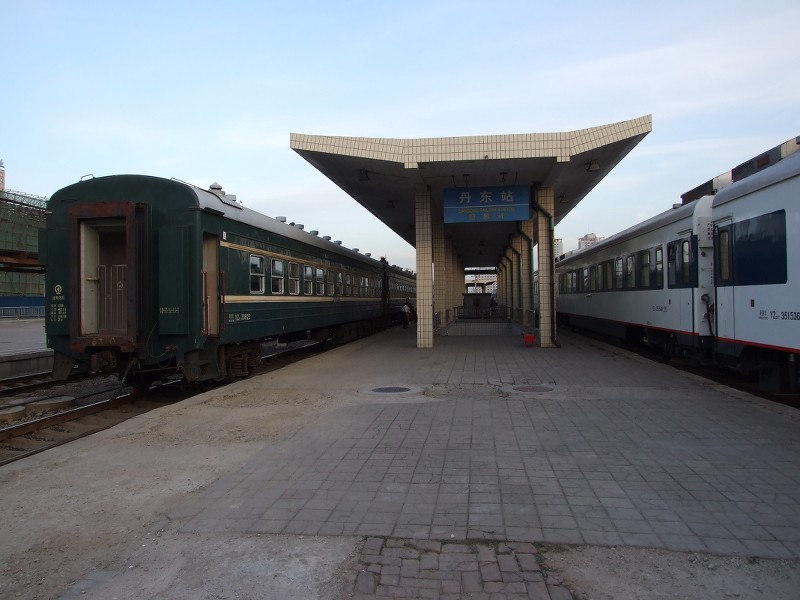
This modern DF11G pulled our train to Beijing:
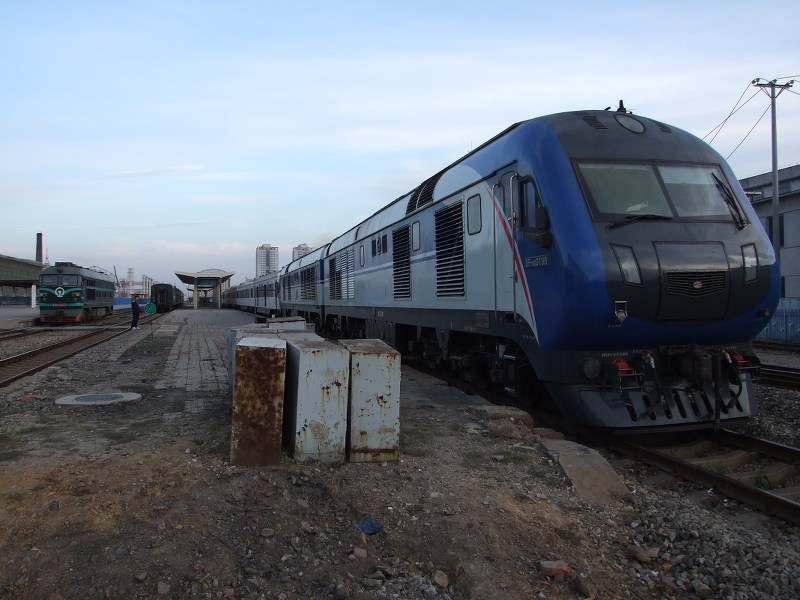
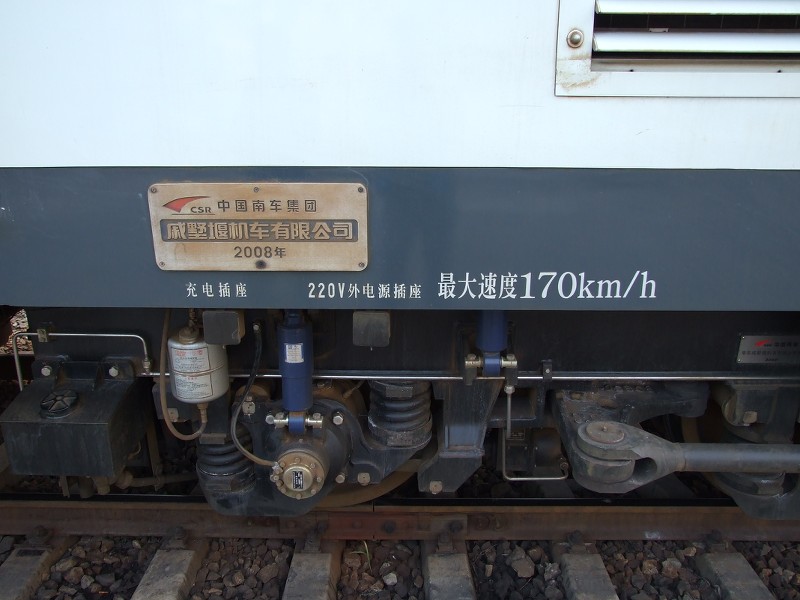
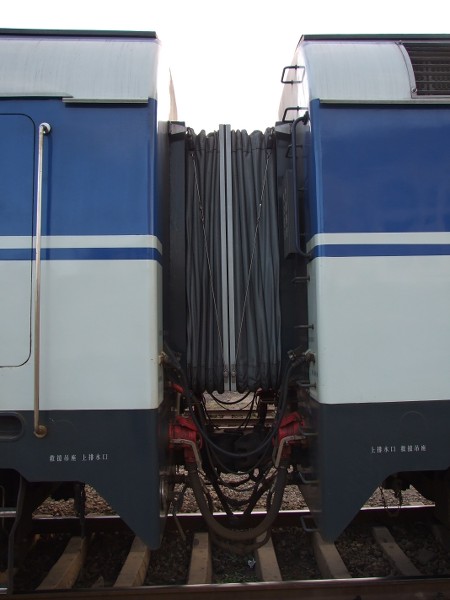
While taking photos a railway employee shouted someting to us, but we didn’t understand him …
The dining car – now we knew where we would have dinner.

We still had about one hour waiting time, so we decided to walk to the Yalu river to have a last glimpse over to North Korea.
We asked our conductors for the tickets (they are needed to re-enter the station) and left the train station. It’s only 800 meters from the train station to the Yalu river.
It was a good feeling to walk around freely. The last time that we did this, was at Tumangan… ;-)
The street to the river was quite busy – cars, buses, people, shops, restaurants…we felt like at home...
The bridge – guess where North Korea begins:


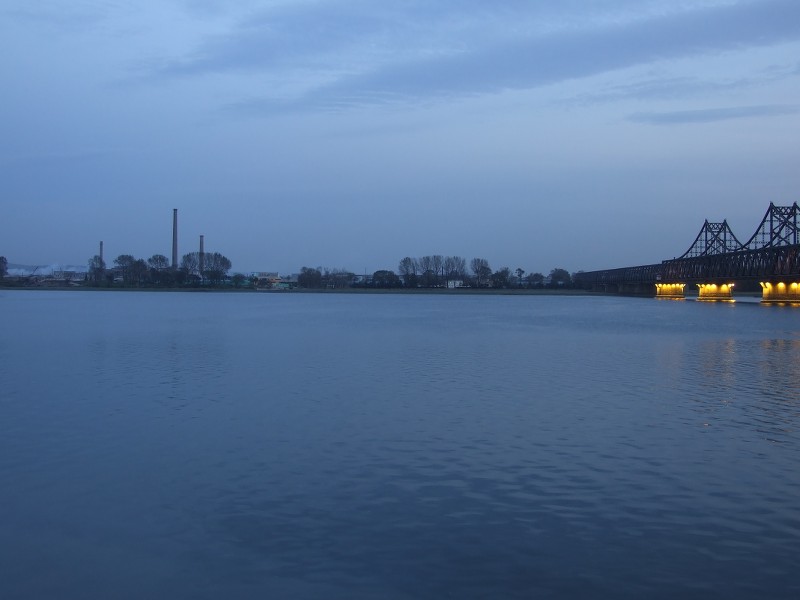
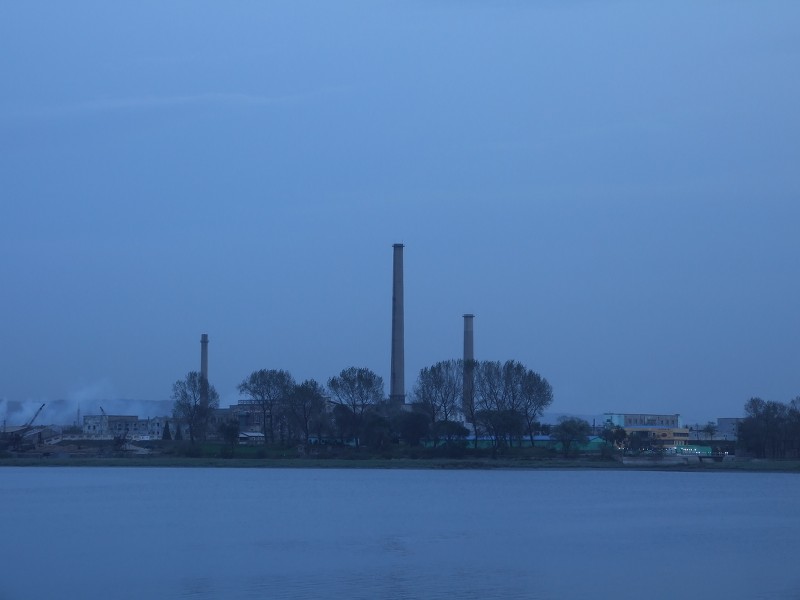
It is a strange feeling to stand here so close to North Korea. Although North Korea is so close and although we had been on the other side just some hours ago it seemed as distant and unreachable as another planet at this moment.
On the way back to the station:
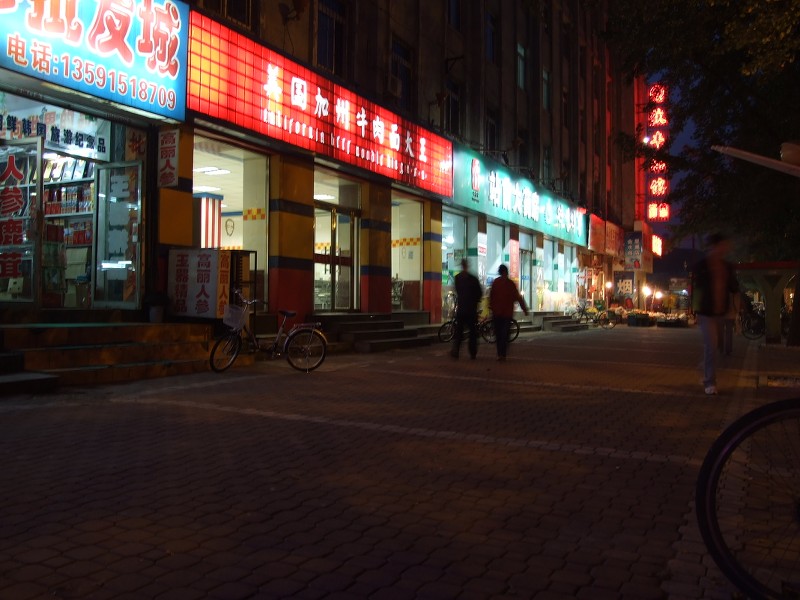
At an ATM we received some Chinese money, then we entered the station and boarded the train.
Just after we departed, we left for the dining-car, which was located 5-6 waggons ahead. The menu in the dining car was only in Chinese, but with the help of the LP guidebook we could order pork sweet-sour with rice.
The dining car was well occupied and also some North Korean passengers had dinner here.
 We then returned to our waggon and sat some while in our compartment. Then I heard some music coming from one of the other compartments and when I had a look on the corridor to find out more, one of the conductors came and guided me to the compartment from which the music came.
We then returned to our waggon and sat some while in our compartment. Then I heard some music coming from one of the other compartments and when I had a look on the corridor to find out more, one of the conductors came and guided me to the compartment from which the music came.The compartment was occupied by three pretty North Korean girls (maybe music students) and a woman (maybe their guide or something similar). I haven’t found out their exact background and why they travelled to Beijing due to the language barrier, but nevertheless it was nice ;-)
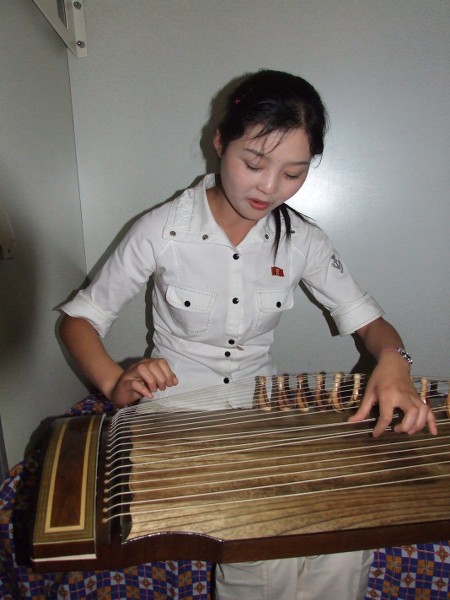
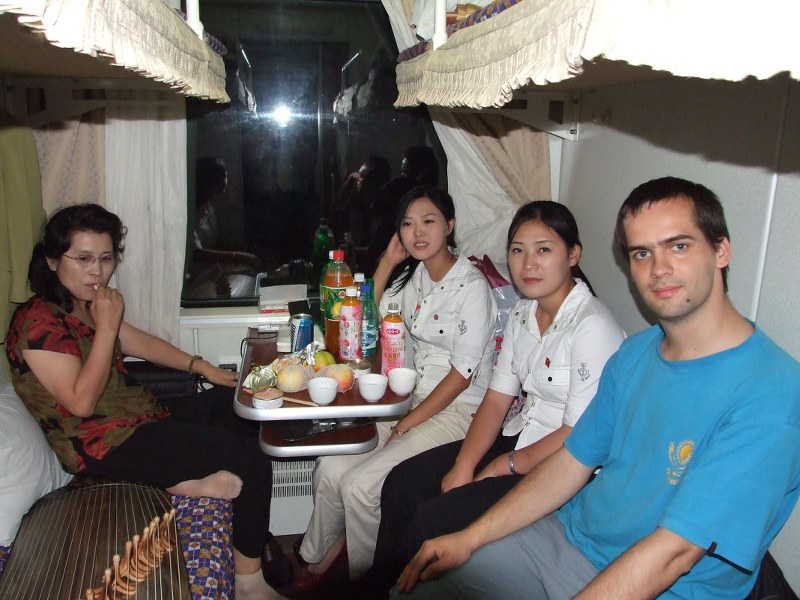
Some videos:
http://www.youtube.com/watch?v=55NRbreU3Ps
http://www.youtube.com/watch?v=x8hDsNcESdk
http://www.youtube.com/watch?v=pa_0VA5XShE
15 minutes stop at Shenyang:
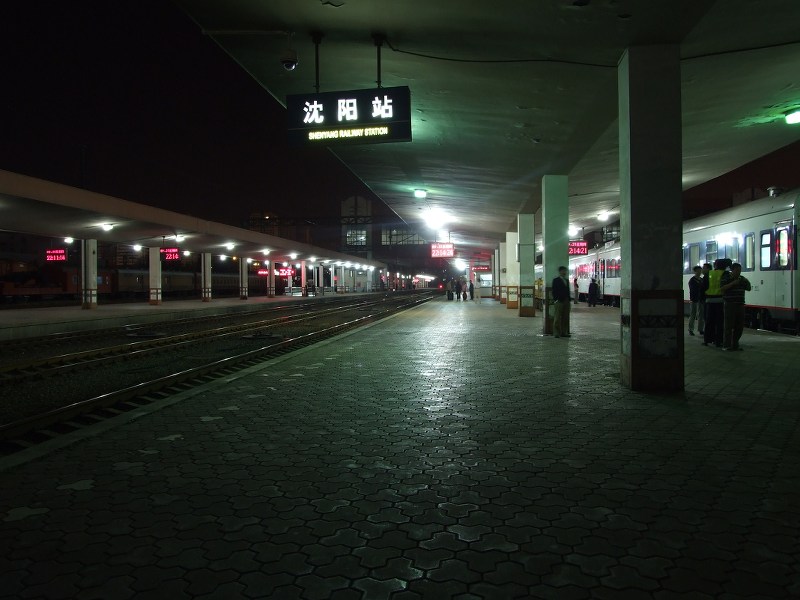
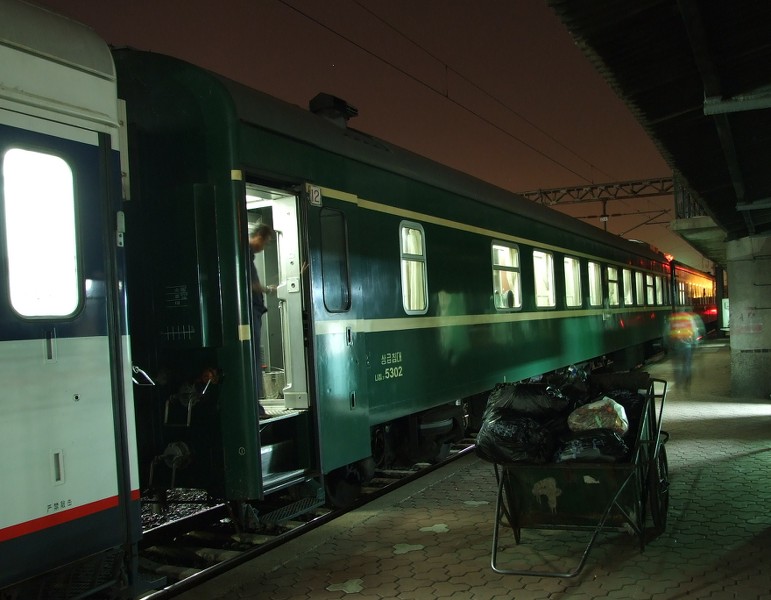
2008-09-26
The train ride during the night was smooth – no ta-tak-ta-tak like in North Korea. The 1132km-trip from Danding to Beijing takes 14 hours, that’s an average speed of 81 km/h.
High speed trains at the new Beijing South station:
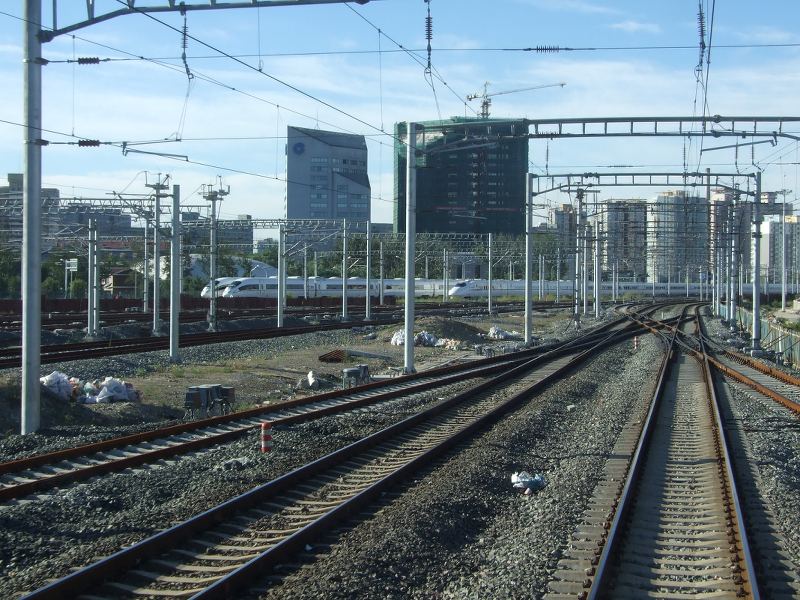
We passed Beijing South station without stopping – what a difference compared to stations in North Korea:
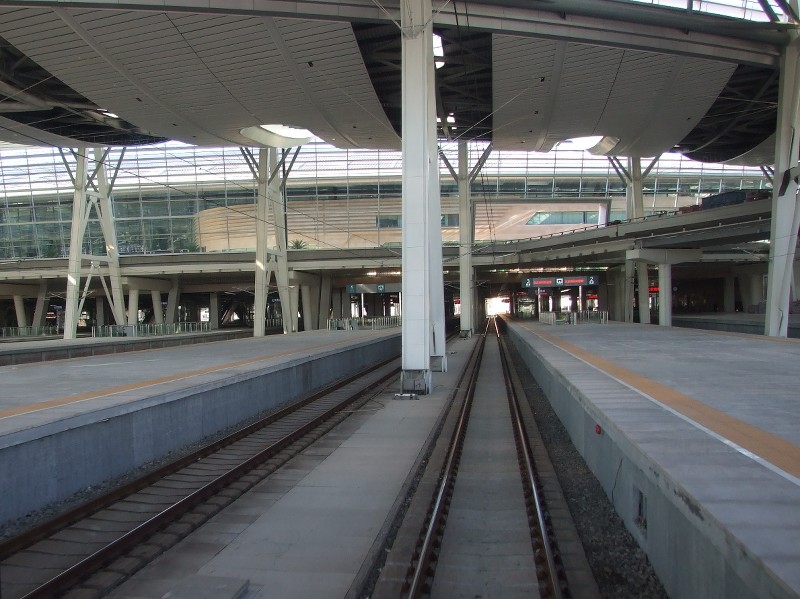 We were overtaken by an ICE-Velaro highspeed-train (CRH3):
We were overtaken by an ICE-Velaro highspeed-train (CRH3):http://www.youtube.com/watch?v=SiODbxxVVJI (this is of course not full speed of the CRH3)
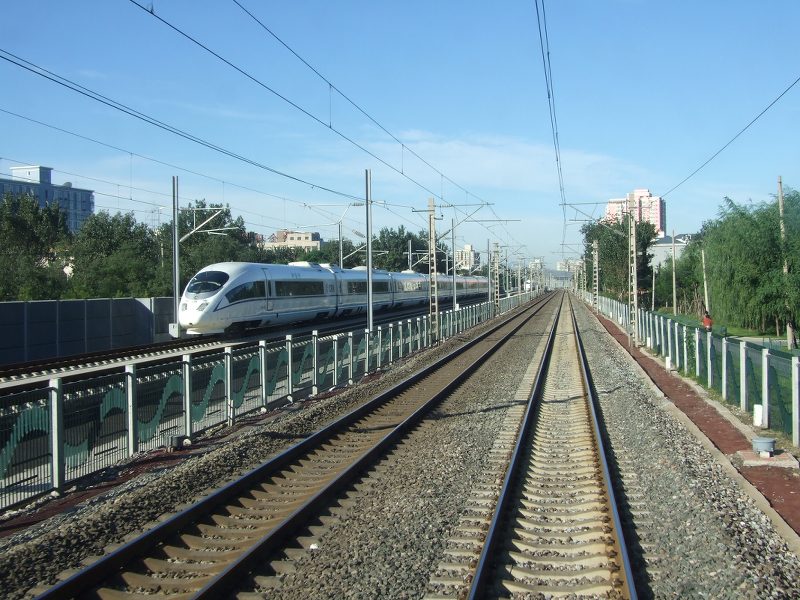
Another highspeed-train:
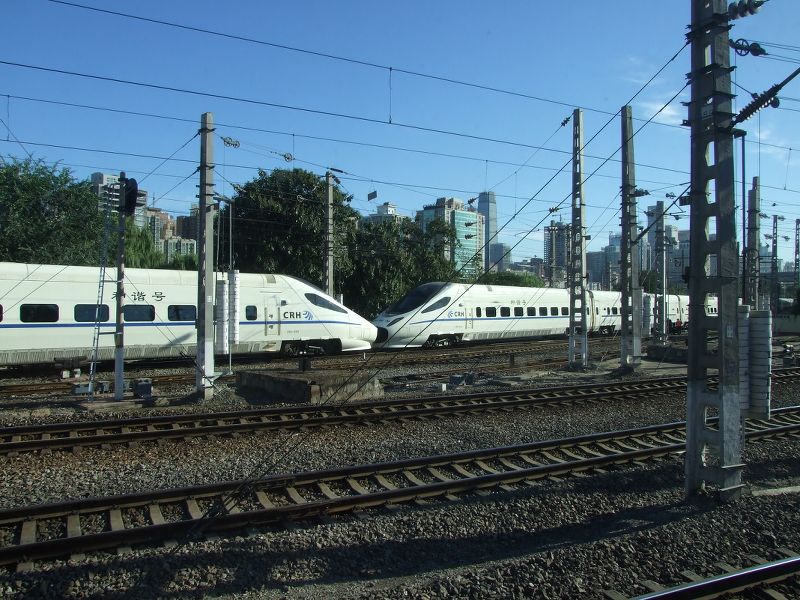
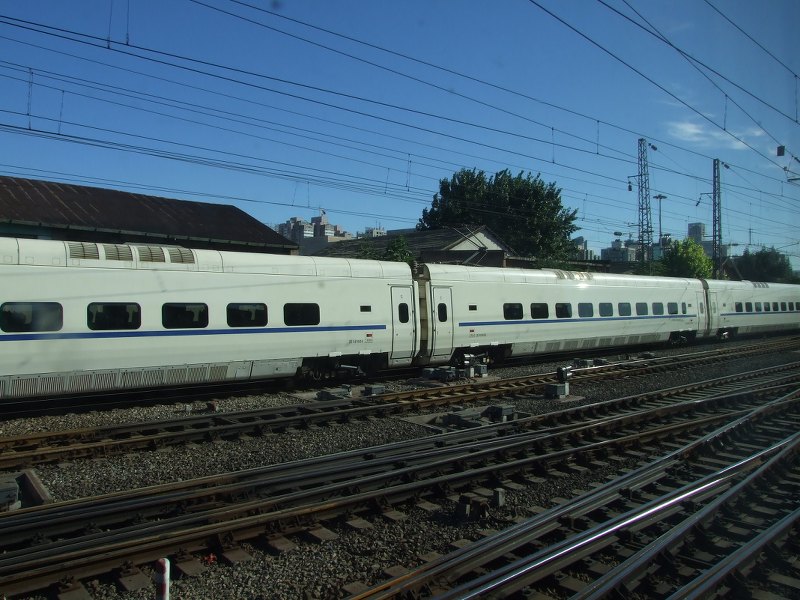
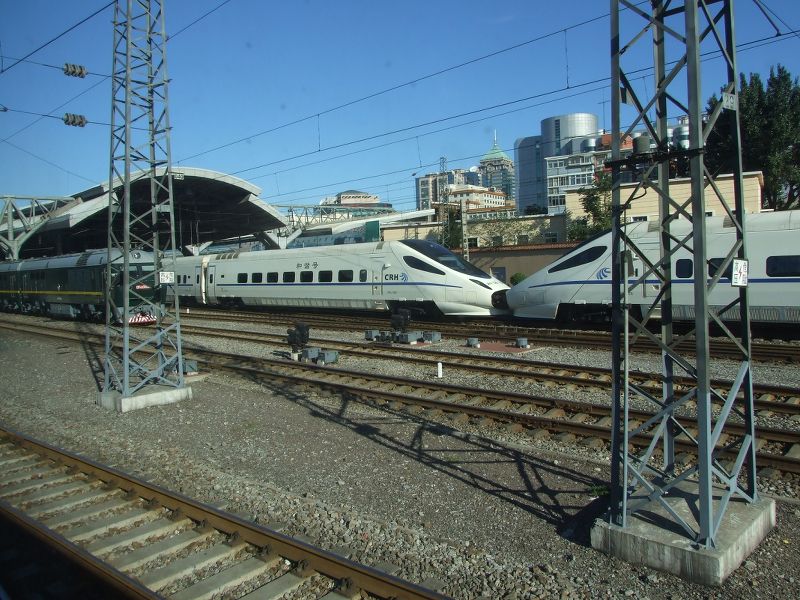
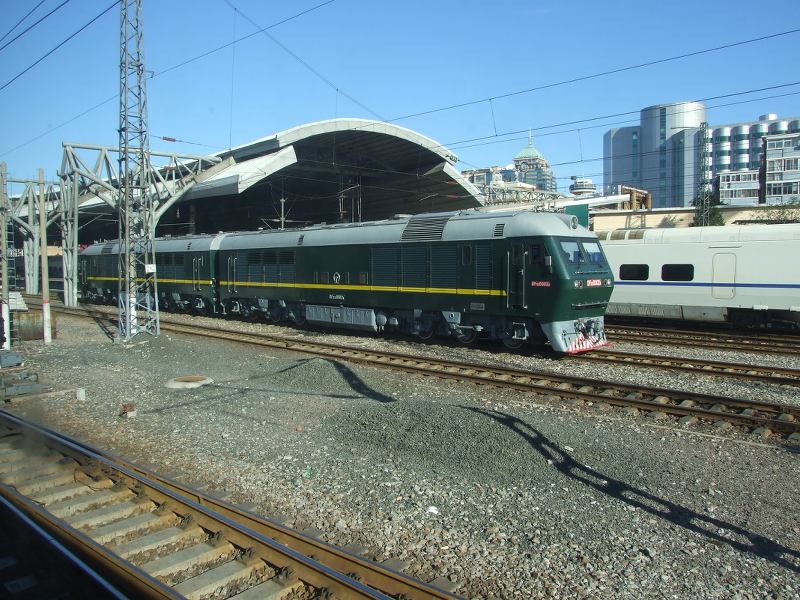
Finally we arrived at Beijing main station:
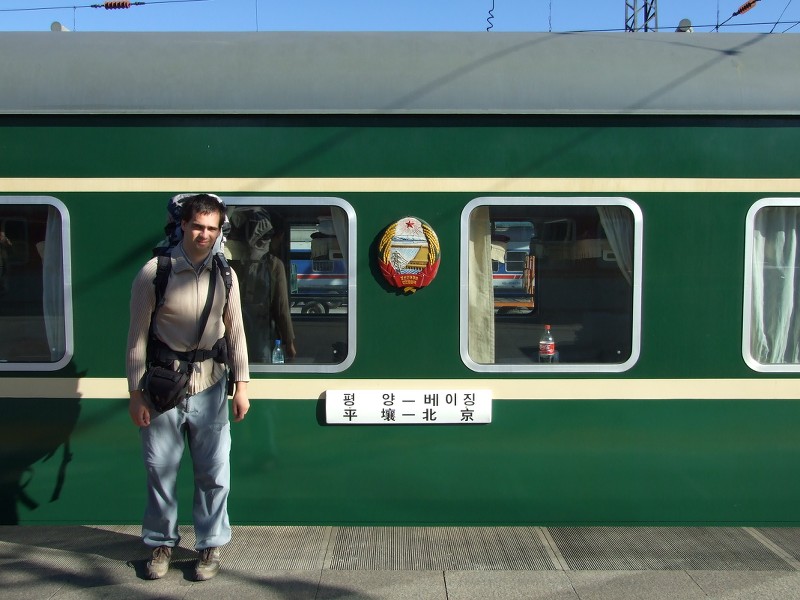
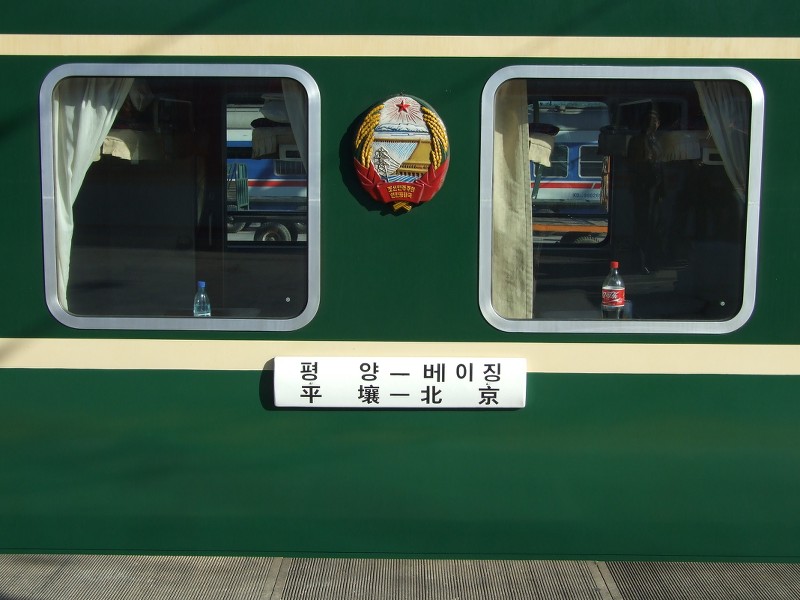
(have a look at the Coca-Cola bottle in the right window…also North Koreans like “imperialistic” softdrinks…)

Our nice fellow passengers are leaving:
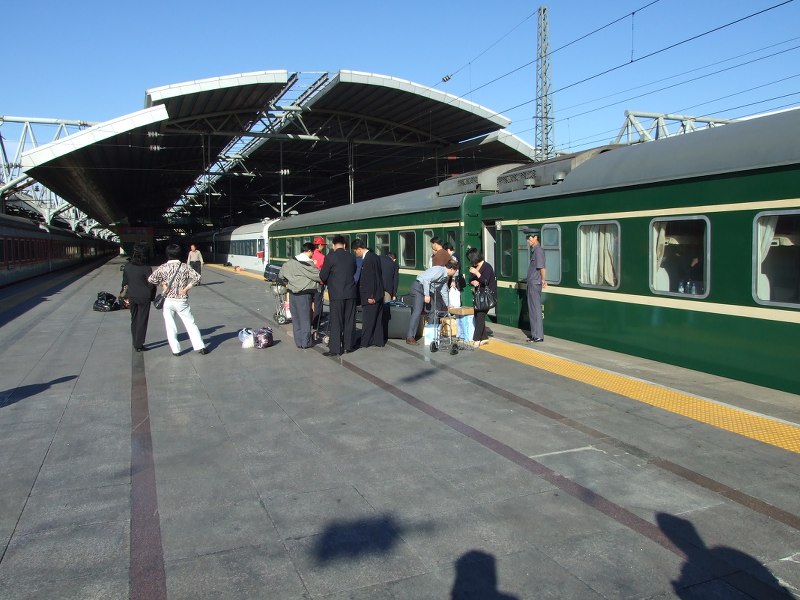


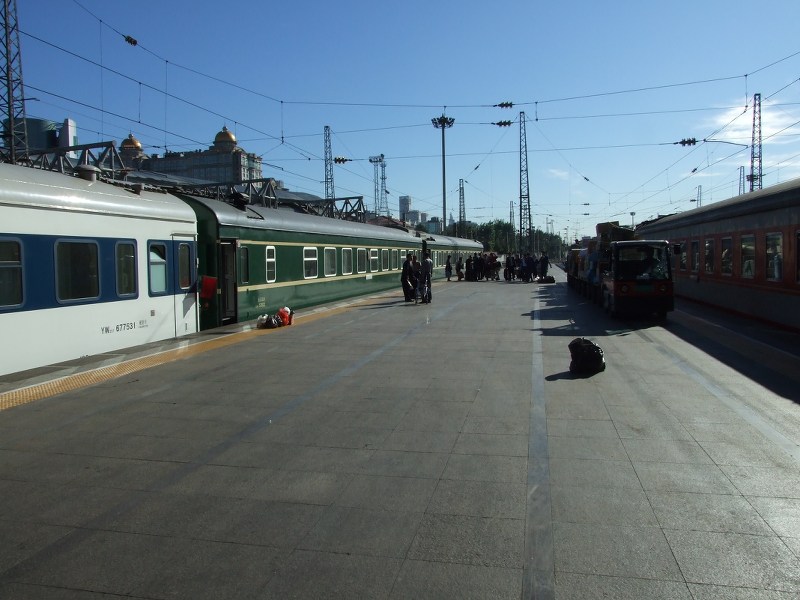
The Chinese part of the train:
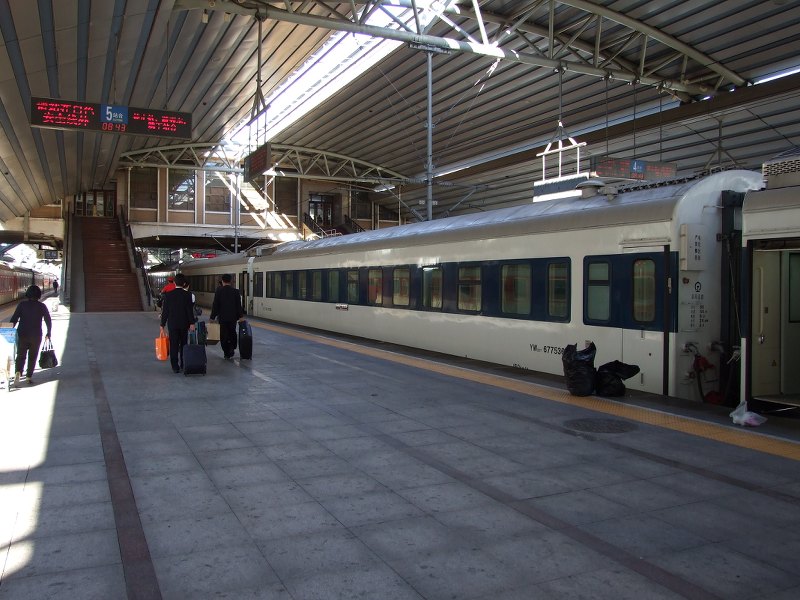
Unloading the luggage waggon:
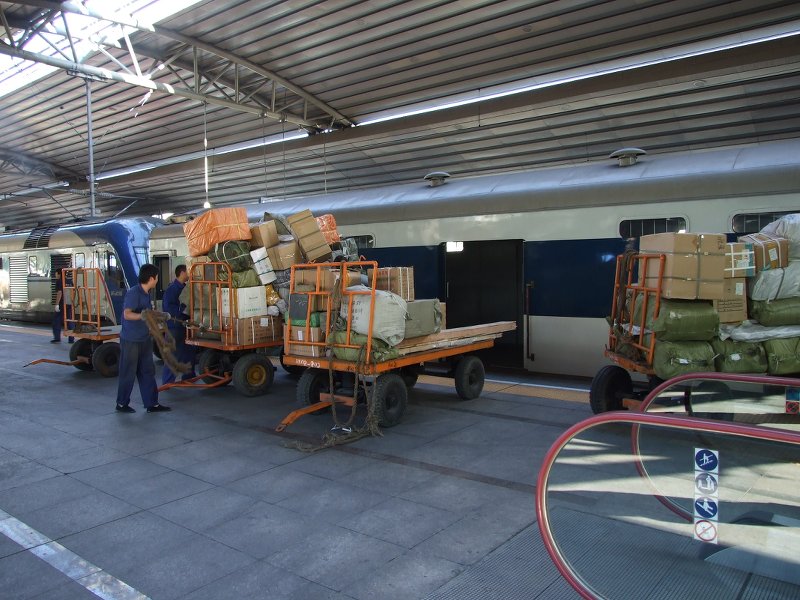
Beijing main station from outside:
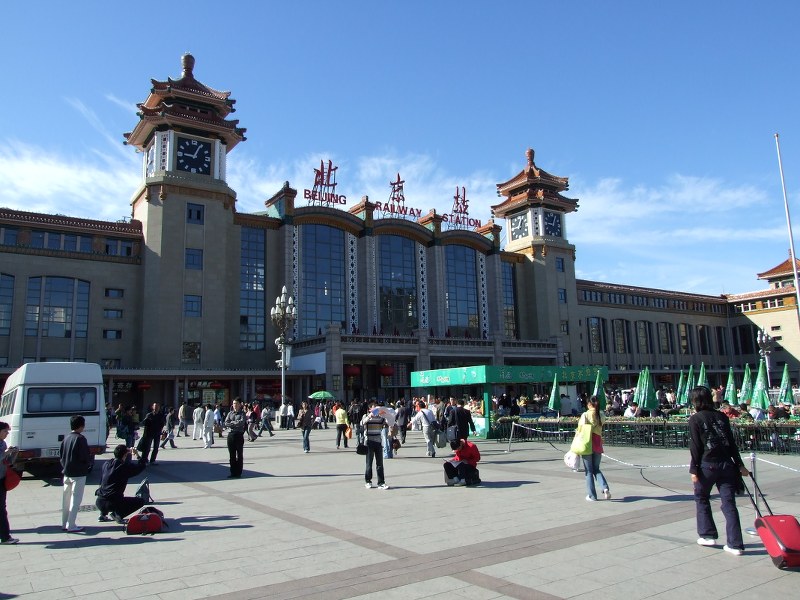
Continue
YOU ALSO WANT TO TRAVEL EUROPE - PYONGYANG BY TRAIN?
Now there is also a travel agency, which can even organize Europe - Pyongyang train trips (but not the route we took). Also I recently found out that theoretically there is a possibility to travel to Rajin via Tumangan legally (but not to Pyongyang).
Click here for more information.
MY OTHER TRIPS
Eurasia 2005: ~35.000 km by train from Europe via Ukraine, Russia and Mongolia to China and back to Europe via Kazakhstan and Uzbekistan:
http://eurasia2005.blogspot.com/
Total solar eclipse 2008: Trip to the total solar eclipse in the Altay mountains (1st august 2008), including a 6-day trekking trip:
http://zatmenie2008.blogspot.com/
MY WEBSITE ABOUT CHEAP TICKETS FOR THE TRANSSIBERIAN RAILWAY
http://citystarticket.blogspot.com/
To be continued...